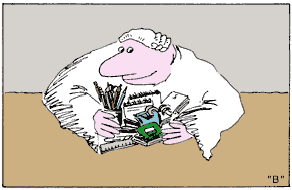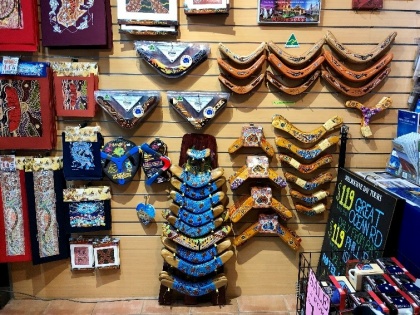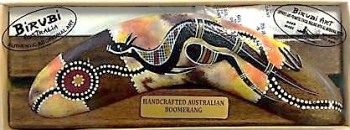
|

News
Is this the end for fake boomerangs? It's not just plastic boomerangs that are fake. It's cheap imported boomerangs from South-East Asia such as Vietnam and Indonesia. If you look at the image, only the boomerangs at the top right were made in Australia. It's not generally known, but an extraordinary statistic that emerged from the evidence given to a recent Parliamentary Inquiry was that 80% of the souvenirs sold in Australia purporting to represent First Nations cultures are in fact imitation products with no connection to Aboriginal peoples. The Inquiry recommended a new law to protect Indigenous Cultural Intellectual Property. In the meantime, the prosecution of Birubi Art, a significant manufacturer and seller of artefacts with Australian Aboriginal Designs, was reaching its conclusion in the Federal Court of Australia. Justice Perry found that the artefacts, their labelling and their packaging gave the misleading impression that they were made in Australia and had been painted by Australian Aboriginal persons. In fact, 50,000 boomerangs, bullroarers, didgeridoos and message stones it sold had been painted with traditional Aboriginal designs in Indonesia by Indonesians. On 26 June 2019, Justice Perry ordered Birupi Art to pay a fine of $2.3 million for breaches of the Australian Consumer Law. But it's a Pyrrhic victory, because Ben Wooster, the owner of Burubi Art had already put the company into liquidation. Before doing so, he transferred the artefacts business to a new company. The business is continuing to operate in Kippa-ring in Queensland. Currently, he is pursuing clothing sellers for unauthorised use of the Aboriginal Flag emblem on clothing, claiming exclusive rights to the emblem from the designer. We can only hope that this episode will be enough to prompt the Federal Government into introducing proper protection for Indigenous Australian culture, especially its artwork and designs. For my case note on the Federal Court decision click Indigenous Australian artistic designs are protected by a new court ruling
Court bans fake boomerangs (made in Indonesia) From 2014 to 2017, Birubi Art sold 18,000 boomerangs, bullroarers, didgeridoos and message stones to tourist outlets. Priced from $9.95, they were sold as cheap souvenirs. Birubi Art labelled the artefacts and their boxes as “genuine Aboriginal Art”, “100% hand painted”, “handcrafted Australian Boomerang” and “Royalties are paid”.
The reality was different. The objects were made by artisans in Indonesia; no Australian Aboriginal person was involved; the only cultural connection was that the designs were created by Trisha Mason an aboriginal artist (who received royalties). Enter the consumer regulator, the ACCC. They prosecuted Birubi Art for false and misleading representations, namely: made in Australia and hand painted by an Australian Aboriginal. On 23 October, 2018, the Federal Court declared these representations were false in breach of the Australian Consumer Law. According to Justice Perry, these artefacts must be made in Australia because they are traditional Australian Aboriginal Cultural artefacts. Souvenir sellers and their suppliers may face prosecution for selling fakes if they are sourced overseas. And if the label says ‘hand painted’, then an Aboriginal person must have done or supervised the painting (i.e. have a more active role than to supply the designs). A hearing on penalties and orders to be made against Birubi Art is pending. For more details click on my case note A boomerang is a fake if it’s not made in Australia (but is labelled as if it was)
How do car rental / hire car businesses overcharge for damage repairs? Hire car businesses are tempted to overcharge customers for vehicle damage repairs, to make them a profit centre, as opposed to passing on the actual repair cost. The ACCC (the Australian Competition and Consumer Commission) takes a dim view of hire car businesses which profit from repairs. It says that – Hire car companies must behave honestly in relation to charges for vehicle repairs and ensure that they have adequate systems in place to refund any overcharged amounts. In July 2013, the ACCC had the Federal Court of Australia fine the former Tasmanian Europcar hire car franchisee $200,000 for misleading and deceptive conduct because it overcharged by deliberately:
The Court also fined the managing director of the franchise, Brendon Ayers, $40,000 for masterminding these contraventions of the Australian Consumer Law. What should the car hire industry do when a vehicle is returned damaged? In the car rental / hire car industry, vehicle damage requires careful management because the repair costs can quickly mount up and affect business profits. For this reason, hire car contracts require the renter to pay a Damage Liability Fee if they return the vehicle damaged. This Fee is a fixed cost estimate calculated to cover the cost of the repairs and third party claims. It is charged by a pre-authorised debit to the renter’s credit card. If Collision Damage Waiver insurance is taken out, the Fee will be less. Later, when the actual Repair Cost and other costs are known, the part not used is refunded to the renter. What did Tasmanian Europcar do when the vehicle damage cost was less than the renter was charged?
The Tasmanian Europcar car rental franchise operator
disregarded the hire car contract it used and the
Europcar Website which contained statements that the
unused part of the Damage Liability Fee would be
refunded. Instead, it overcharged its customers by –
Using two-tier invoicing where the car rental business could conceal the fact that it paid less for the Repair Cost than it charged the customer for the same vehicle repair. This is how it worked -
What happened in the Tasmanian Europcar case? The ACCC alleged that the non-refund and the two-tier invoicing was conduct that was misleading and deceptive or likely to mislead or deceive the car rental customers and was unconscionable in contravention of the Australian Consumer Law. The Federal Court found significant contraventions and losses under the Australian Consumer Law, which were deliberate and were designed to profit the business over the consumer. The civil penalty was $200,000 for the car rental business operator; and $40,000 for its managing director. These were not criminal proceedings because the conduct is not a criminal offence. Therefore the Court did not need to consider whether imprisonment might be appropriate. The ACCC’s action effectively put Tasmanian Europcar out of business. Europcar terminated the franchise agreement early, took over the fleet, and employed the staff. Europcar Australia has introduced a new charging model that customers are only charged for vehicle damage once an independent assessor has reported on the exact cost of the repairs. Europcar Australia was not a party to the proceedings and no orders were made against it.
For a more detailed analysis, google my article:
The ACCC targets hire car companies for
overcharging for damage repairs – the Federal
Court orders a $200,000 civil penalty. Law Case Alert! A fall from a top bunk creates a $853,396 migraine!
The award On 26 June 2009, the Supreme Court of NSW
awarded $853,396 to compensate a child for brain damage,
medical expenses and future loss of earnings caused by
falling from the top bunk of a bunk bed in a private home.
The decision was reported as Thomas v Shaw [2009] NSWSC 510.
As published in the Backpackers Trade Magazine |
|||||||||||||||||||||||||||||||||||
|
© Copyright 2022 Cordato Partners |
||||||||||||||||||||||||||||||||||||

